
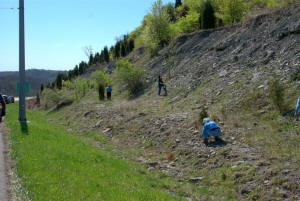
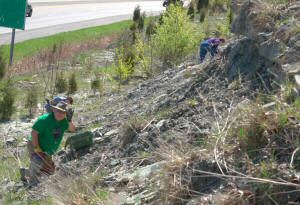
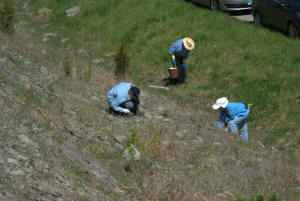
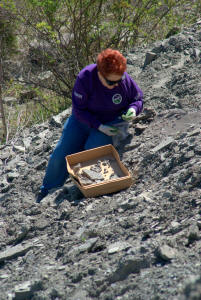
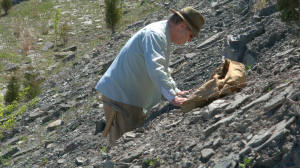
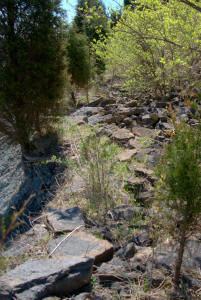
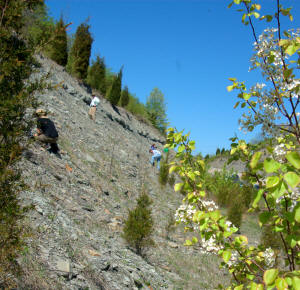
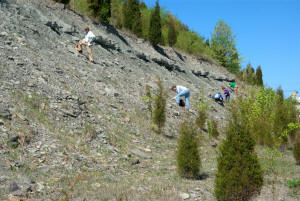
Photos and words by Bill Heimbrock
The Dry Dredgers had a dry and pleasant day for the April field trip, which was in contrast to the drizzly day we had for our March field trip.
This month we returned for a tour of some road cuts along a scenic byway in Northern Kentucky. Gas prices were up to $3.89 per US gallon (which is high for us), so stops were chosen that were close to Cincinnati.
Our first stop was to a site that exposes the lower Fairview Formation and the upper Kope formation. These rocks are about 450 million years old. The fossils are from animals of the Late Ordovician Period, a time when a shallow sea covered this part of the continent, which was then near and below the equator, making it a tropical paradise of marine invertebrates.
Here are some photos of the nice spring day we had and the Dry Dredgers doing their thing, surface collecting nicely preserved and abundant fossils.
Fossils Found that day: Site 1 (Lower Fairview/Upper Kope Formations)
Cephalopods
Almost immediately after stepping out of the car, we found
examples of huge straight-shelled nautiloid cephalopods in the upper Kope slabs.
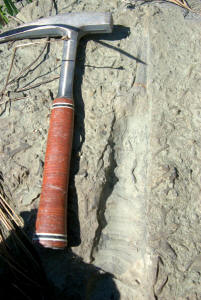
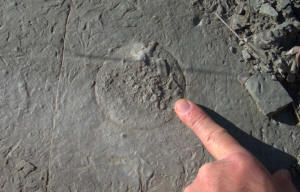
Lots of other straight-shelled nautiloids were found at site 1
preserved as internal molds and/or calcite replacements. This next photo shows a
cross-section of a siphuncle, which is a tube that runs along the internal
length of the orthocone.
This next example is odd because it's a bit disarticulated. It
looks like a crinoid stem, but the chambers of the cephalopod replaced with
calcite can be seen.
You can see this same preservation in these next two specimens
of cephalopods.
We also came across cephalopods that were filled in with shale
and fossil hash.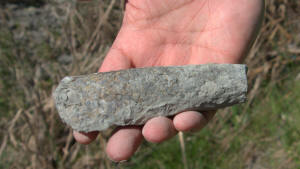
Here is a real puzzler. I have heard that the bryozoan Spatiopora sp. which encrust nautiloid cephalopods align their monticules in the direction of the cephalopods travel, perhaps to reduce water resistance. That makes sense, right?
Here's a cephalopod specimen found at site#1 that's encrusted
on both sides with Spatiopora sp..One of those sides
(second picture below) is a partial cast of the cephalopod shell, with
Spatiopora sp. encrusting the inside structure and the
monticules are still aligned in the direction of travel. How can this happen?
The cephalopod was dead when the shell was partially filled in with silt. Did
the bryozoan encrusted the silty cast of the shell? Or was the bryozoan on
originally on the outside surface of the cephalopod shell when the animal was
alive and continued to encrust the cast after the cephalopod was dead and the
shell disintegrated? Send your thoughts to Bill Heimbrock at
billheim@cinci.rr.com.)
Crinoids
In several spots there were pockets of crinoid stems but no
other body parts of the crinoid, such as the calyx (cup) were found. The species
is hard to identify from the stem, but thanks to resources such as
Jack Kallmeyer's and Ron Fine's Crinoid
stem web page, it is possible. The stems below are likely to be
Cincinnaticrinus varibrachialus and
Ectenocrinus simplex. Both of these are
common in the Kope and Fairview Formations.
Trilobites
Probably the best trilobite found at site #1 was this inverted
exoskeleton of a Flexicalymene sp. (next 2 pics). This could be of the species
F. granulosa or F. meeki. It's
probably a molt because the thorax segments look like
they have separated and the hypostoma (mouth plate)
is missing. But the free cheek is broken rather than
separated along the suture, as is happens when Flexis molt. So I'm not certain
in this case. 
This ichnofossil (trace fossil) may be the tracks/burrow of a
trilobite, possible a Flexicalymene. There are signs
of foot marks moving in the mud.
Most often, fragments of Flexicalymene species are found on
the surface of rocks and shale. Can you identify the
Flexicalymene parts in this photo (below)?
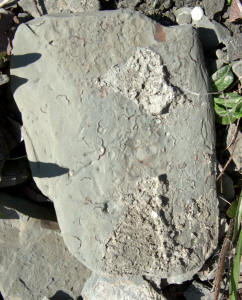
The other trilobite we found parts of was the very large
Isotelus sp.. In the photo below, we found a large fragment of either the
cephalon (head) or the
pygidium (tail).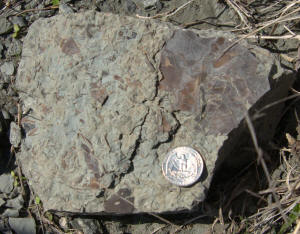
Bryozoans
As is true for almost all fossil sites in the Cincinnati Ohio,
Northern Kentucky and Southeast Indiana region, bryozoans are abundant. But one
particular type of bryozoan is limited to the Fairview formation and we found
quite a few examples of it. I'm referring to
Escharopora falciformis. (next 3 photos)
Other than that species, the brozoans we found were hugely
abundant on site 1. We found some massive trepostomate bryozoans...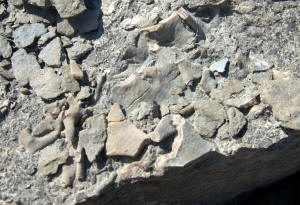
And we found lots and lots of ramose (branching) bryozoans.
(remaining photos)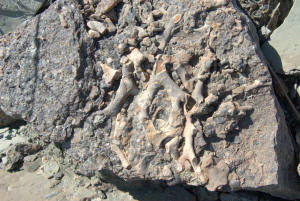

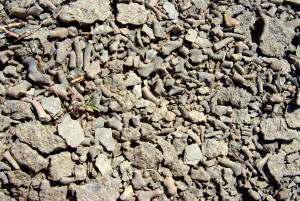
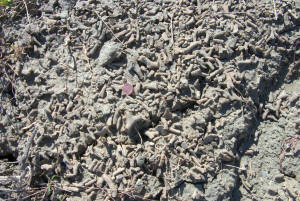

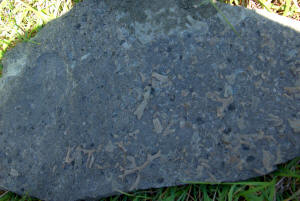
Brachiopods
The most common brachiopod we found at the Fairview and upper
Kope formation site #1 was Cincinnetina multisecta
(formerly Dalmanella multisecta and Onniella multisecta).
Gastropods (snails)
The only gastropod I saw that day on site 1 was this example
of
Paupospira bowdeni.
Graptolites
Yes, we even found graptolites, thanks to Dry Dredgers vice
president, Rich Fuches.
Ichnofossils (trace fossils)
Trace fossils abounded on site 1. This first one is a
bit of a mystery. These burrows are denser than the surrounding shale, allowing
them to come above the eroded surface of this slab.
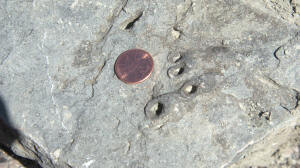
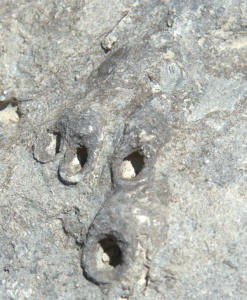
An interesting and common trace fossil we found were
Diplocraterion. These are "U"
shaped burrows that look like dumbells on the surface, having a bulge at either
end (first picture). From the side of the rock, you can see that the burrows go
vertically down into the substrate and form a "U" shape.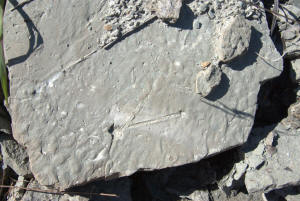

The site had lots of other trace fossils on shale surfaces.
Stromatoporoid?
I'm not sure of the identification of this fossil. It looks
like a bryozoan, but it could be a stromatoporoid, which are currently thought
to be sponges.
The second stop was to a site that is described
as an exposure of the middle Kope formation. 
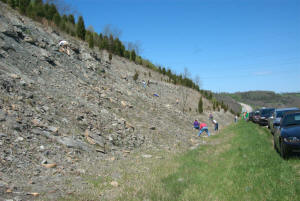
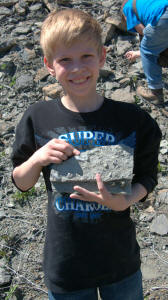
Fossils Found that day: Site 2 (Middle Kope Formation)
Site 2: Cephalopods
As the pictures below show, there was some excellent brown calcite internal molds of straight-shelled nautiloid cephalopods.
Site 2: Bryozoans
Oddly enough, we found several spear-shaped bryozoans with diamond-shaped zoecia we recognized as Escarapora sp.. But I would guess the species is probably Escharopora acuminata because it was found in the middle Kope rather than the Fairview formation.
Other bryozoans found include massive bryozoan structures.
There were some "leafy" trepostomate bryozoans
found.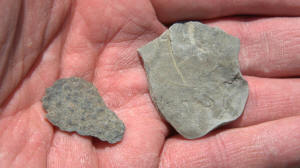
And branching (ramose) bryozoans were abundant. 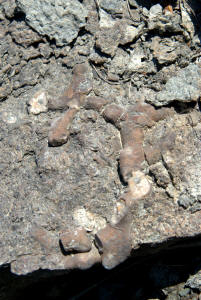
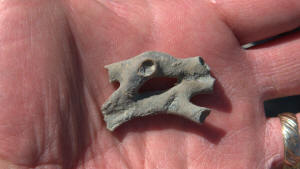
Site 2: Crinoids
Here's an interesting crinoid stem. It's grouped with some
similar-looking bryozoans. Can you spot the crinoid stem in the next photo? I
think this is Anomalocrinus sp., which frequently
keeps company with bryozoans.
Here are a couple of pictures of the holdfast of the crinoid
Anomalocrinus sp. It attaches to bryozoans and often has a shape like a
"volcano."
This next crinoid stem is also very interesting. It's highly
weathered and looking at it edge-on (second photo) the underside looks as though
it's missing. It makes this crinoid stem look like a few other types of fossils.
Other crinoid stems found on rock surfaces were more clearly
Ectenocrinus simplex.
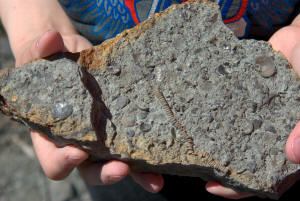
Site 2: Brachiopods
Rafinesquina sp. were abundant on
site #2.
We found a layer in which the brachiopod Rafinesquina sp. was
shingled and pushed around in the now-lithified mud. The layer indicates a large
storm event in our geologic past.

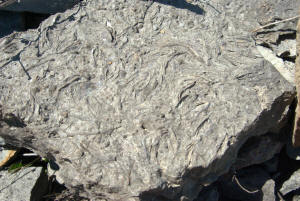
Cincinnatina multisecta (formerly
Dalmanella or Onniella multisecta) are also abundant in certain layers on site#2. These
layers, like the shingled Rafinesquina, act as marker
beds for finding the relative position of the bed in the strata.
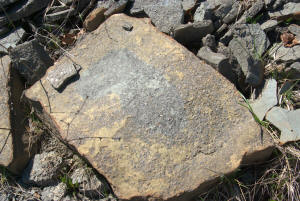
Site 2: Trilobites
No whole trilobites were found that day on site#2. We did find fragments of Flexicalymene sp. trilobites. Here is a glabella (part of the head) of Flexicalymene sp..
Isotelus sp. fragments.were found on the surface of rocks, as shown in the next 3 photos.
That's it for this field trip. I hope you enjoyed it. If you want to know more about the sites along this scenic northern Kentucky byway, join the Dry Dredgers!
See previous trips down this scenic byway in northern Kentucky
Now let's see our May 2014 field trip to the Bellevue and Corryville Formations.
Back to the Field Trip Index Page
Return to Dry Dredgers Home Page
The Dry Dredgers and individual contributors reserve the
rights to all information, images, and content presented here. Permission to
reproduce in any fashion, must be requested in writing to admin@drydredgers.org.
www.drydredgers.org is designed and maintained by Bill Heimbrock.